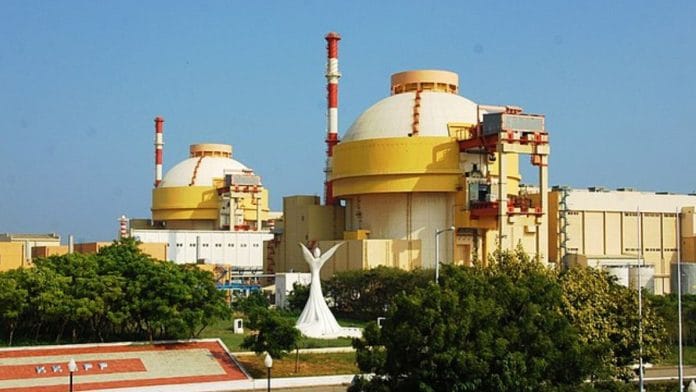Thank you dear subscribers, we are overwhelmed with your response.
Your Turn is a unique section from ThePrint featuring points of view from its subscribers. If you are a subscriber, have a point of view, please send it to us. If not, do subscribe here: https://theprint.in/subscribe/
India’s advancement in the realm of civil nuclear energy has remained tepid, but recently, in the backdrop of India’s aim to achieve net-zero emissions by 2070, the Central Government, in a commendable move during the Union Budget 2025–26, has launched the “Nuclear Energy Mission for Viksit Bharat” to enhance domestic nuclear capabilities, accelerate the deployment of advanced nuclear technologies such as Small Modular Reactors (SMRs), and achieve the 100 GW nuclear power capacity by 2047. SMRs here can play a crucial role in meeting the growing energy needs of the country sustainably, as nuclear energy is an important low-emissions technology. The SMRs offer modularity, scalability, a small footprint, and improved safety, and can be built across the country, especially in locations not suitable for large nuclear plants, producing large amounts of low-carbon electricity. Recently, the Prime Minister’s visit to the US comes as a shot in the arm for the Civil Nuclear Program of India, where the role of SMRs was emphasized and it was envisioned “To build large U.S.-designed reactors and enable collaboration to develop, deploy and scale up nuclear power generation with advanced SMRs.” Here, the involvement of private players is important in mitigating the apprehensions and providing certitude in the establishment and use of the SMRs, along with the generation of employment for the local population and awareness programs in collaboration with the government.
But to ensure smooth participation of the private sector, a few of our statutes require amendments, and as promised by our Finance Minister during the budget session, the amendments required have been discussed below.
Key Amendments Needed in the Atomic Energy Act, 1962
Section 20 of the AEA, 1962 explicitly bars any kind of patent being granted to technology pertaining to atomic energy, which excludes private firms from investing in SMR technology, despite their expertise in modular manufacturing and supply chains. Although the caution of the Indian government is understandable, the strict oversight over nuclear energy development requires a thaw.
Allowing private companies (also in collaborations) to own or operate nuclear reactors and incentivize research and development in the sector of atomic energy. This does not mean that we sacrifice our safeguards. Section 20 can still be amended to allow private companies (both domestic and foreign) to own, develop, and operate SMRs under strict regulatory oversight. A Public-Private Partnership (PPP) model, where private firms collaborate with NPCIL or BARC, should be introduced to accelerate SMR deployment.
This is also important as weak patent enforcement and concerns over forced technology transfer will discourage international SMR companies from bringing their proprietary designs to India. Instead, a Nuclear IP Licensing Framework ensuring that foreign SMR firms retain IP rights while allowing Indian companies to develop indigenous SMR variants legally in collaboration would ensure greater participation of foreign firms and realization of the 123 Agreement with the USA.
Key Amendments Needed in the Civil Liability for Nuclear Damage Act (CLNDA), 2010
India’s Civil Liability for Nuclear Damage Act (CLNDA), 2010 brought in a robust framework for compensating victims of nuclear incidents, but it interdicted foreign investment and the expansion of India’s nuclear energy sector. One such provision is Section 17(b), which grants the operator a right of recourse against suppliers in cases where a nuclear accident occurs due to defective equipment or services. Unlike global best practices where nuclear liability is exclusively borne by the operator, our law puts additional onus on the suppliers, making them reluctant to engage in business with Indian operators. To encourage foreign collaboration, the liability needs to be restricted to cases of willful misconduct or gross negligence, ensuring liability is aligned with international standards and does not unduly burden suppliers beyond contractual obligations.
However, Section 4 of the Act already imposes absolute and exclusive liability on the operator (NPCIL) in case of a nuclear accident, irrespective of fault or negligence. This provision is consistent with international nuclear liability norms and is based on the principle of channeling liability solely to the operator. Yet, Section 17(b) indirectly contradicts this by opening a backdoor for shifting liability to suppliers, creating significant legal uncertainty. This may act as an impediment to foreign suppliers like Westinghouse, EDF, and Rosatom. It is necessary to relook Section 17(b) and restrict it to cases of willful misconduct, gross negligence, or mala fide intent by the supplier.
Conclusion: For the realization of India’s nuclear ambitions, particularly the deployment of Small Modular Reactors (SMRs), India needs to create a favorable legal and regulatory environment. To meet its net-zero emissions goal by 2070, India must modernize its nuclear legal framework—transforming it into a catalyst for growth rather than a deterrent.
These pieces are being published as they have been received – they have not been edited/fact-checked by ThePrint.


